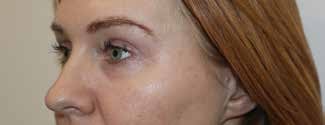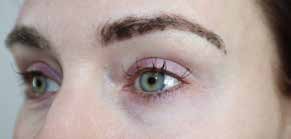Enhancing plasma treatment results with POLYNUCLEOTIDES HPT
Independent nurse prescriber Kate Monteith Ross and aesthetic nurse practitioner Eleanor Turrell investigate the benefits of combining plasma therapy with polynucleotides HPT.

Before
Periorbital ageing is a common aesthetic concern, with plasma therapy emerging as a promising treatment modality, and polynucleotides highly purified technology (HPT) showing potential in tissue repair and regeneration. This study investigates whether combining the two enhances outcomes compared to using plasma therapy alone.
We aimed to assess whether pre-treatment with polynucleotides HPT could enhance the results of plasma treatment by improving periorbital skin quality. A cohort of patients received polynucleotides HPT(Plinest Eye by Mastelli) followed by NeoGen Plasma treatment, while another cohort received NeoGen Plasma treatment alone. Patients refrained from using skincare products, collagen supplements, or undergoing light therapy during the study period. The study protocol involved three sessions of NeoGen Plasma treatment four weeks apart for the first cohort, while the second cohort received Plinest Eye followed by NeoGen Plasma treatment, spaced two weeks apart. Objective assessments and patient-reported outcomes were used to evaluate treatment efficacy.
PLASMA THERAPY
By generating plasma from nitrogen gas, NeoGen creates a controlled thermal energy that is precisely delivered to the target area. This energy creates controlled damage, which stimulates the production of collagen to rejuvenate aged and damaged skin. 1
A study conducted in 2018 reviewed NeoGen’s effectiveness on 18 patients aged 20-50 with mild to moderate periorbital wrinkles. Each were treated on one side of their face at three-week intervals and compared with their untreated side. After 14 weeks, all had a significant improvement for their periorbital wrinkle score according to the Lemperle scale, skin wrinkle (Sew) score by Visioscan VC 98, and the melanin index by Mexameter (P = 0.004, P < 0.001, p < 0.001, respectively). Participants also described greater satisfaction with the treated side of wrinkles and only shortterms side effects such as redness, dryness and temporary hyperpigmentation.2
Furthermore, clinical research has noted an average of 22% in upper eyelid tightening, with positive effects for treating rosacea, keloid scarring, and moderate to severe acne scarring.3 In a literature review written by Professor Syed Haq, he notes that plasma treatment is a “unique form of non-ablative resurfacing that leaves a layer of intact desiccated epidermis that acts as a natural biologic dressing and promotes rapid healing”. He continued by highlighting how it has been shown to improve fine lines, moderate to deep rhytids and the texture and tone of photoaged skin. Speaking specifically about NeoGen, Professor Haq adds, “The broad range of energy settings enables the clinician to personalise treatments with controlled injury leading to reduced recovery times and maximising clinical effect.” 3
POLYNUCLEOTIDES HPT
Research highlights that, historically, hyaluronic acid-based products have been used for this periocular region, 4 however polynucleotides HPT have a more significant restorative effect over longer time frames. 5
Our brand of choice – Plinest and Plinest Eye – is made from polynucleotides HPT extracted in a harm-free way from trout DNA. A polynucleotide is a sequence of nucleotides, as in DNA or RNA, bound into a chain. Plinest comprises 20mg/ml of polynucleotides HPT, while Plinest Eye contains 7.5mg/ml of polynucleotides HPT. Either can be used in the periorbital region – choice is dependent on patient and practitioner. 6
When injected intradermally, Polynucleotides HPT promotes a trophic and stimulating action on existing fibroblasts. It enhances the growth rate and metabolic action of fibroblasts which, in turn, can accelerate regeneration of the skin, synthesise collagen and initiate repair processes. 6
Research has also found that Plinest and Plinest Eye can be used a skin primer, with evidence indicating that they can make skin more receptive to laser, radiofrequency, fillers, chemical peels, microneedling and surgery. 6
It therefore makes sense to also evaluate its effectiveness in combination with NeoGen.
METHODS
A total of six patients with periorbital concerns were enrolled in this prospective, single-centre study. Patients were divided into two equal cohorts: one receiving NeoGen Plasma treatment alone (Group A), and the other receiving polynucleotides HPT (Plinest Eye by Mastelli) followed by NeoGen Plasma treatment (Group B). Exclusion criteria included concurrent use of skincare products, collagen supplements, or light therapy during the study period. Group A received three sessions of NeoGen plasma treatment, spaced four weeks apart, while Group B underwent three sessions of Plinest Eye followed by NeoGen Plasma treatment, two weeks apart.
Objective assessments were conducted using images taken with a Canon EOS M50 camera at the beginning and the end of the study. Patients also underwent a self-assessment using the FACE-Q scale to assess overall skin, facial appearance, eye satisfaction, upper eyelid satisfaction and lower eyelid satisfaction.
Additionally, patients completed a questionnaire that asked them to rate the appearance of certain facial features and the impact this had on their confidence and day-to-day life. Patients were treated with a vertical and horizontal two step pass to ensure the energy was passed uniformly in the areas of treatment. 3
RESULTS
Preliminary analysis suggests a noticeable improvement in periorbital skin quality in both groups. However, Group B, receiving combined Plinest Eye and NeoGen Plasma treatment, exhibited a more significant improvement compared to Group A who received NeoGen Plasma treatment alone.
Group B also scored the downtime more favourably. Patient scores were higher in Group B, indicating enhanced treatment outcomes.
In summary, Group A’s (NeoGen Plasma alone) mean periorbital concern scores were:
● Prior to treatment: 2.3
● Following treatment: 4 This demonstrates a 73.91% improvement.
Group B’s (Plinest Eye and NeoGen Plasma) mean periorbital concerns scores were:
● Prior to treatment: 2.2
● Following treatment: 3.9 This demonstrates a 77.27% improvement.
Participants treated with both Plinest Eye and NeoGen Plasma noted more than 50% improvement in their downtime and more than 40% better experience during the treatment itself, compared to those treated with NeoGen Plasma alone.
CONCLUSION
Both treatment protocols led to improvements in participants’ skin condition, reflecting NeoGen’s effectiveness in promoting skin rejuvenation. While using NeoGen Plasma alone demonstrated positive outcomes, it did incur longer recovery times than those who also received treatment with Plinest Eye.

After
This suggests that the addition of polynucleotides HPT prior to NeoGen Plasma treatment may accelerate the skin’s healing process and enhance overall results. Participants treated with Plinest Eye also noted a more comfortable treatment process.
Finally, participants treated with both products reported a significantly higher mean improvement percentage (77.27%) compared to those treated with plasma therapy alone (73.91%).
Overall, our findings underscore the potential benefits of incorporating polynucleotides HPT as a pre-treatment to optimise the effectiveness of plasma therapy for skin rejuvenation.
Further research with larger sample sizes and longer follow-up periods is warranted to validate these findings and elucidate the underlying mechanisms of action. Nevertheless, our study provides valuable insights into the potential synergistic effects of priming the tissue with Plinest Eye, before a treatment of NeoGen Plasma, to achieve superior clinical outcomes and reduce downtimes.
REFERENCES
1. NeoGen, What can NeoGen do for you? (UK: Energist, 2024)
2. Theppornpitak N, Udompataikul M, Chalermchai T, Ophaswongse S, Limtanyakul P. Nitrogen plasma skin regeneration for the treatment of mild-tomoderate periorbital wrinkles: A prospective, randomized, controlled evaluator-blinded trial. J Cosmet Dermatol. 2019 Feb;18(1):163-168. doi: 10.1111/jocd.12767. Epub 2018 Aug 26. PMID: 30146783.
3. Professor Syed Haq, Energy Work (UK: Aesthetic Medicine, 2018)
4. Ziai K, Lighthall JG. Periocular rejuvenation using hyaluronic acid fillers. Plast Aesthetic Re. 2020;7:53.
5. An innovative PN HPT based Medical device for the therapy of deteriorated preiocular skin quality. Surg res 2023. Volume 5 issue 2 1-7. Isabella Palmiera, Ledaa Moro, Nadia Fraone, Carmen de luca, caroline Prussia.
6. Cavailinni M, Barloletti E, Maio L. on behalf of The Polynucleotides HPT Priming board, Collegio Italiano della societa Scientifiche de medicina esthtica (Italian college of the aesthetic medicine scientific societies) SIME, AGORA, SIED. Consensus report on the use of PN HPT in aesthetic medicine. J Cosmet Dermatol. 2021; 20: 922-928.